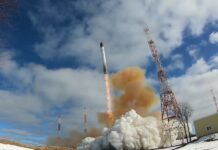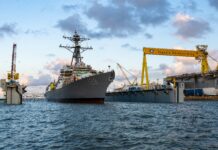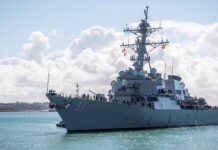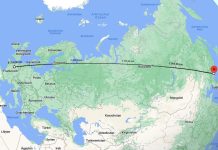On 18 November 2022, North Korea conducted a test launch of an intercontinental ballistic missile (ICBM), which was announced the following day by North Korean news agency KCNA, with 23 photos documenting the launch. This was the second North Korean test of an ICBM in three weeks, with an earlier attempt on 3 November presumably a failure. Pyongyang rates the 18 November test as a success, which can be seen from the rhetoric and the level of detail in the information provided by KCNA. The ICBM in question was the relatively new Hwasong-17 (also known as Hwasongpho-17).
According to Japanese reports, the missile impacted about 210 km West of the Japanese island of Oshima in the Sea of Japan, about 300 km West of Fukushima. KCNA stated that the missile was launched at 10:15 local time, and the flight lasted for 4135 seconds, during which the missile travelled a distance of 999.2 km and reached a maximum altitude of 6,040.9 km. The alleged launch site as Pyongyang International Airport does not coincide with the published pictures, an inconsistency that occurred for reasons of secrecy. During its 69-minute flight, the Hwasong-17 allegedly reached a maximum speed of Mach 22, which would be expected to occur in the terminal phase for a missile of this type. This figure is based on information from Seoul, although analysis by the intelligence services in South Korea and the United States is still ongoing.
Some countries in Southeast Asia are analysing the nature of the threat. Japanese Defence Minister Yasukazu Hamada said the missile had a range of more than 15,000 km, a statement based on a South Korean expert who believes that the Hwasong-17 could carry three to five nuclear warheads. The North Korean regime first unveiled the intercontinental ballistic missile at a military parade in October 2020.
The two previously tested ICBM types, Hwasong-14 and Hwasong-15, have a range of about 8,000 km. With these, Pyongyang can threaten Hawaii, Alaska and the US Pacific coast. The Hwangsong-17 on the other hand could reach any point in the US mainland.
North Korea has conducted more than fifty missile tests this year. Particularly provocative was the launch of a medium-range missile that flew over Japan on 3 October 2022, which caused Tokyo to call on the population to seek safety. The international community responded harshly to Pyongyang’s escalations, with Seoul, Tokyo and Washington condemning the tests. UN Secretary-General António Guterres urged the North Korean regime to comply with the Treaty on the Non-Proliferation of Nuclear Weapons and to return to the IAEA agreement. The EU is doing the same, with the High Representative for Common Foreign and Security Policy, Josep Borrell, stating: “The EU strongly condemns the launch by North Korea of an intercontinental ballistic missile that landed in Japan’s exclusive economic zone on 18 November. The EU is deeply concerned by this dangerous, illegal and reckless action.”
To be sure, there are repeated signs that patience with North Korea is running out, however the regime is also finding backing elsewhere. In May 2022, Russia and China vetoed a UN Security Council resolution introduced by the US to tighten sanctions on North Korea over its weapon tests. Pyongyang considers the military presence of the United States in South Korea and Japan to be a hostile act, and it justifies its weapons tests as a reaction to the US’ military exercises in the region. The regime sees its military exercises and the missile tests as a legitimate response to what it perceives as an existential threat. In this respect, nuclear deterrence is an indispensable element of the regime’s security policy. A communiqué issued by the Communist Party of North Korea on 19 November 2022 states: “This was done within the framework of the strict implementation of the strategy of the Workers’ Party of Korea and the North Korean government, which is to constantly strengthen the strongest and most absolute nuclear deterrent.” For Kim Jong Un, there may be the added rationale that nuclear deterrence is the only way he can hold his own against external threats. For the North Korean leader, the fates of Saddam Hussein and Muammar al-Gaddafi may have been lessons he remembers.
Hans Uwe Mergener












